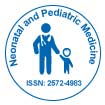Neonatal Opioid Withdrawal Syndrome (NOWS): Understanding and Addressing a Growing Concern
Received: 03-Feb-2025 / Manuscript No. nnp-25-171024 / Editor assigned: 06-Feb-2025 / PreQC No. nnp-25-171024 / Reviewed: 18-Feb-2025 / QC No. nnp-25-171024 / Revised: 22-Feb-2025 / Manuscript No. nnp-25-171024 / Published Date: 28-Jan-2025
Introduction
Neonatal Opioid Withdrawal Syndrome (NOWS) is a condition that affects newborns exposed to opioids in utero. As maternal opioid use, whether prescribed or illicit, has increased globally, so too has the incidence of NOWS. The syndrome occurs when infants experience withdrawal symptoms after birth due to the sudden discontinuation of opioid exposure. NOWS can manifest through a range of physiological and behavioral signs, including tremors, irritability, poor feeding, vomiting, diarrhea, sleep disturbances, and, in severe cases, seizures. Understanding NOWS is essential for early identification, effective management, and improving long-term outcomes for affected infants [1], [2].
Discussion
NOWS primarily arises from maternal opioid use during pregnancy, which can include prescription pain medications, methadone or buprenorphine therapy for opioid use disorder, and illicit substances like heroin. The severity and duration of withdrawal symptoms in newborns depend on multiple factors, including the type of opioid, maternal dosage, timing of exposure during pregnancy, and whether the infant was exposed to other substances such as nicotine or benzodiazepines [3], [4].
Diagnosis of NOWS involves careful clinical assessment using standardized scoring systems, such as the Finnegan Neonatal Abstinence Scoring System (FNASS). This tool evaluates a range of signs including neurological excitability, gastrointestinal dysfunction, autonomic disturbances, and behavioral symptoms. Scores help healthcare providers determine the severity of withdrawal and guide decisions regarding pharmacologic and non-pharmacologic interventions [5], [6].
Management of NOWS focuses on supporting the infant through withdrawal while minimizing discomfort and preventing complications [7], [8]. Non-pharmacologic strategies are often the first line of care, emphasizing a low-stimulation environment, swaddling, frequent small feedings, and close maternal-infant contact. For infants with moderate to severe symptoms, pharmacologic treatment may be necessary, often involving gradual weaning with opioids such as morphine or methadone under strict medical supervision. Multidisciplinary care teams, including neonatologists, nurses, social workers, and lactation consultants, play a crucial role in ensuring holistic care for both the infant and mother.
Early intervention and supportive care are critical for reducing the risk of long-term neurodevelopmental and behavioral issues. Research suggests that infants with NOWS who receive timely, consistent, and individualized care are more likely to achieve normal growth and developmental outcomes. Additionally, maternal engagement in treatment programs and support systems is essential to reduce the risk of continued opioid exposure and to promote family stability [9], [10].
Conclusion
Neonatal Opioid Withdrawal Syndrome (NOWS) is a growing public health concern that reflects the broader challenges of opioid use during pregnancy. Prompt recognition, careful assessment, and comprehensive management are essential to ensure the well-being of affected infants. Non-pharmacologic interventions, supplemented by pharmacologic therapy when necessary, provide effective care, while maternal support and treatment programs help prevent recurrence. Addressing NOWS requires collaboration among healthcare providers, families, and communities to mitigate the short- and long-term consequences of opioid exposure in newborns. Through education, early intervention, and supportive care, it is possible to improve outcomes and foster healthier beginnings for infants affected by this syndrome.
References
- Grignon A, Filion R, Filiatrault D, Robitaille P, Homsy Y, et al. (1986) Urinary tract dilatation in utero: classification and clinical applications. Radiol 160: 645-647.
- Ocheke IE, Antwi S, Gajjar P, McCulloch MI, Nourse P (2014) Pelvi-ureteric junction obstruction at Red Cross Children’s Hospital, Cape Town:a six year review. Arab J Nephrol Transplant 7: 33-36.
- Capello SA, Kogan BA, Giorgi LJ Kaufman RP. Prenatal ultrasound has led to earlier detection and repair of ureteropelvic junction obstruction. J Urol (2005) 174: 1425-1428.
- Johnston JH, Evans JP, Glassberg KI, Shapiro SR (1977) Pelvic hydronephrosis in children: a review of 219 personal cases. J Urol 117: 97-101.
- Williams DI, Kenawi MM (1976) The prognosis of pelviureteric obstruction in childhood: a review of 190 cases. Eur Urol 2: 57-63.
- Lebowitz RL, Griscom NT (1977) Neonatal hydronephrosis: 146 cases. Radiol Clin North Am 15: 49-59.
- Hubertus J, Plieninger S, Martinovic V, Heinrich M, Schuster T, et al. (2013) Children and adolescents with ureteropelvic junction obstruction: is an additional voiding cystourethrogram necessary? Results of a multicenter study. Wor J Urol 31: 683-687.
- Swenson DW, Darge K, Ziniel SI, Chow JS (2015) Characterizing upper urinary tract dilation on ultrasound: a survey of North American pediatric radiologists’ practices. Pediatr Radiol 45: 686-694.
- Hussain, Walid A, Jeremy D (2019) Approaches to Noninvasive Respiratory Support in Preterm Infants: From CPAP to NAVA. NeoReviews 20:213–221.
- Bordessoule, Alice (2012) Neurally Adjusted Ventilatory Assist Improves Patient–Ventilator Interaction in Infants as Compared with Conventional Ventilation. Pedia Res 72:194–202.
Citation: David G (2025) Neonatal Opioid Withdrawal Syndrome (NOWS): Understanding and Addressing a Growing Concern. Neonat Pediatr Med 11: 509.
Copyright: © 2025 David G. This is an open-access article distributed under the terms of the Creative Commons Attribution License, which permits unrestricted use, distribution, and reproduction in any medium, provided the original author and source are credited.
Select your language of interest to view the total content in your interested language
Share This Article
Recommended Journals
Open Access Journals
Article Usage
- Total views: 221
- [From(publication date): 0-0 - Dec 10, 2025]
- Breakdown by view type
- HTML page views: 163
- PDF downloads: 58
